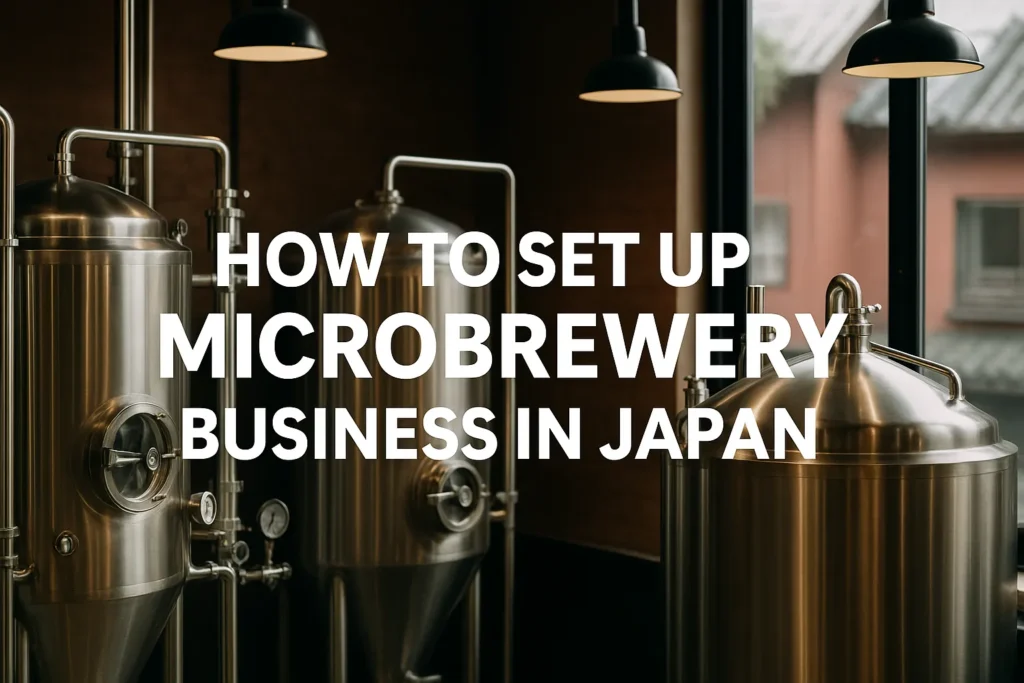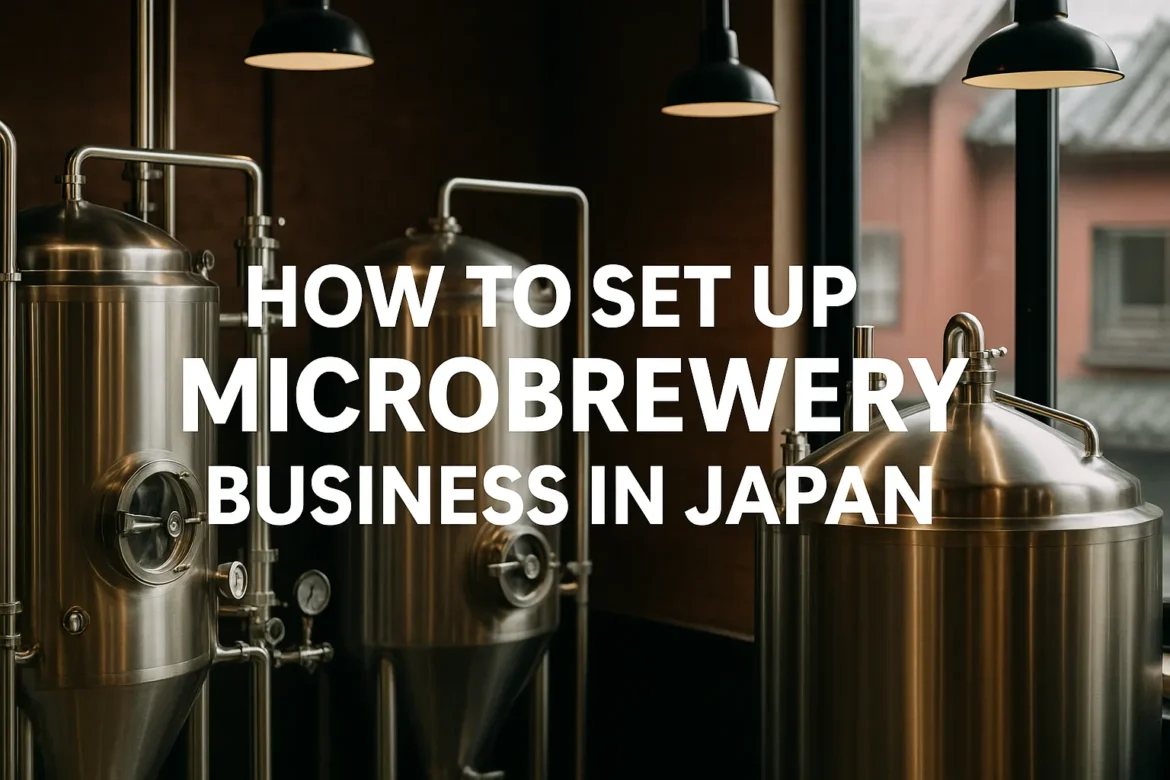Discover how to set up a microbrewery in Japan—costs, licenses, equipment, and tips to launch a profitable craft beer business.
The first time I stepped into a Japanese microbrewery back in 2012, I was in Yokohama visiting a small sake barrel workshop when the owner casually mentioned his neighbor was aging beer in his old shochu casks. That neighbor turned out to be one of Japan’s pioneering craft brewers, and that moment changed my entire perspective on what’s possible when traditional Japanese brewing meets modern craft beer innovation. Now, after spending years consulting for Japanese breweries and helping establish three successful microbreweries across Kanto and Kansai, I’m here to share everything you need to know about starting a microbrewery in Japan.

Japan’s craft beer scene has exploded from just a handful of breweries in the mid-1990s to over 400 thriving operations today. The market value has reached an impressive USD 8.0 billion in 2024, with projections showing growth to USD 23.4 billion by 2033 – that’s a staggering CAGR of 12.61% according to IMARC Group. But here’s what makes Japan truly special: it’s not just about copying Western styles anymore. Japanese brewers are creating something entirely unique, incorporating yuzu, matcha, wasabi, and even aging beers in sake barrels.
If you’re seriously considering starting a microbrewery in Japan, you’re looking at one of the most exciting yet challenging markets in Asia. The combination of discerning consumers, strict regulations, and fierce competition from both domestic giants and imported craft beers creates a landscape that demands excellence. But for those who navigate it successfully, the rewards – both creative and financial – are extraordinary.
The Japanese Beer Revolution: Understanding Your Market
Let me paint you a picture of modern Japan’s beer scene. Walk through any major city – Tokyo, Osaka, Nagoya – and you’ll find craft beer bars tucked into narrow alleyways, department stores dedicating entire floors to beer selections, and convenience stores stocking local microbrews alongside the ubiquitous Asahi and Kirin. This transformation didn’t happen overnight.
The 1994 Watershed Moment
Prior to 1994, starting a microbrewery in Japan was essentially impossible. The law required breweries to produce at least 2 million liters annually – that’s about 17,000 barrels, roughly what a large regional brewery in the US produces. This effectively created a monopoly for the big four: Asahi, Kirin, Sapporo, and Suntory.
When the government lowered the minimum production requirement to 60,000 liters (about 512 barrels) in 1994, everything changed. Suddenly, small-scale brewing became viable. The first wave included pioneers like Echigo Beer (claiming to be Japan’s first microbrewery), followed by Kiuchi Brewery’s Hitachino Nest in 1996 and Baird Brewing in 2000.
Current Market Dynamics
Today’s Japanese craft beer market presents fascinating opportunities:
| Market Segment | 2024 Value | 2033 Projection | Growth Rate |
|---|---|---|---|
| Overall Beer Market | $24.7 billion | $31.2 billion | 3.5% CAGR |
| Craft Beer Segment | $8.0 billion | $23.4 billion | 12.61% CAGR |
| Premium Beer | $14.3 billion | $18.9 billion | 3.2% CAGR |
| Low/No-Alcohol | $2.1 billion | $4.7 billion | 9.4% CAGR |
The demographic driving this growth? Primarily 25-35 year olds in urban areas, with increasing interest from women and older consumers seeking quality over quantity. They’re willing to pay ¥800-1,200 for a craft beer compared to ¥300-400 for mainstream lagers.
Navigating Japan’s Regulatory Framework
Here’s where starting a microbrewery in Japan gets complex. I’ve helped breweries navigate this maze, and I can tell you – it’s not for the faint-hearted. The Japanese government treats alcohol production with the seriousness of a traditional tea ceremony.
The License Labyrinth
First, understand that brewing beer in Japan falls under the Liquor Tax Law (酒税法), administered by the National Tax Agency. Yes, you read that right – tax officials, not food safety inspectors, are your primary regulators. Here’s what you need:
1. Brewer’s License (酒類製造免許)
- Minimum production: 60,000 liters/year
- Processing time: 2-6 months (but I’ve seen it take up to a year)
- Cost: ¥150,000 license fee
- Requirements: Detailed business plan, proof of brewing expertise, financial stability
2. Food Production License (食品製造許可)
- Required for any food/beverage production
- Obtained from local health authorities
- Includes facility inspections
- Cost: ¥30,000-50,000
3. Business Registration
- Standard company registration (kabushiki kaisha or godo kaisha)
- Foreign owners can establish 100% foreign-owned entities
- Initial capital requirements vary by prefecture
The Critical Requirements
What the tax office really wants to see:
- Financial Proof: At least ¥10 million in capital (though I recommend ¥20-30 million)
- Technical Expertise: Certification of brewing skills (this is where many applications fail)
- Dedicated Facility: You cannot brew in a restaurant kitchen or shared space
- Detailed Business Plan: 3-year projections, distribution strategy, production schedules
Pro tip from my experience: Hire a specialized administrative scrivener (行政書士) who deals with alcohol licenses. The ¥300,000-500,000 fee is worth avoiding months of bureaucratic nightmares.
Investment Reality Check: The True Costs
Let’s talk money – real numbers from actual projects I’ve been involved with. Starting a microbrewery in Japan requires significant capital, but the investment varies dramatically based on your approach.
Complete Investment Breakdown
| Category | Budget Option | Standard Setup | Premium Setup |
|---|---|---|---|
| Equipment | ¥15-25 million | ¥30-50 million | ¥60-100 million |
| Facility | ¥5-10 million | ¥15-25 million | ¥30-50 million |
| Licensing | ¥1-2 million | ¥2-3 million | ¥3-5 million |
| Initial Inventory | ¥2-3 million | ¥4-6 million | ¥8-12 million |
| Marketing | ¥2-3 million | ¥5-8 million | ¥10-15 million |
| Working Capital | ¥5-8 million | ¥10-15 million | ¥20-30 million |
| Total | ¥30-51 million | ¥66-107 million | ¥131-212 million |
| (USD equivalent) | $200-340K | $440-713K | $873K-1.4M |
Equipment Considerations
Japanese brewing equipment manufacturers like Fujiwara Techno-Art offer excellent quality at competitive prices. A 500-liter system from a Japanese manufacturer costs about ¥25-30 million, while imported German equipment might run ¥40-50 million.
However, consider this: many successful Japanese microbreweries started with used equipment from sake breweries. I helped one brewery in Nagano acquire a complete 300-liter system from a closing sake brewery for just ¥8 million – a fraction of new equipment costs.
Success Stories: Learning from Japan’s Craft Beer Pioneers
Hitachino Nest: The Sake Brewery’s Beer Revolution
When I first visited Kiuchi Brewery in Ibaraki, I was struck by how seamlessly they’d integrated beer production into their 200-year-old sake operation. Starting beer production in 1996, they faced immediate challenges – the owner knew nothing about brewing beer, and Japanese breweries weren’t exactly eager to help potential competitors.
Their solution? They looked abroad, bringing in North American expertise and equipment. By 1998, their White Ale won gold at the World Beer Cup. Today, they export to over 20 countries and have become Japan’s most recognizable craft beer brand internationally.
Key Lessons:
- Leverage existing expertise (fermentation knowledge transfers between sake and beer)
- Don’t be afraid to seek international partnerships
- Quality and consistency win over novelty
Baird Brewing: The Gaijin Success Story
Bryan Baird, an American, started with a tiny 30-liter system in Numazu in 2000. Today, Baird operates multiple taprooms across Japan and a significant production facility. What’s remarkable is how they’ve navigated being foreign-owned in a traditionally Japanese industry.
Their strategy? Deep integration with local communities, using Japanese ingredients, and respecting Japanese business culture while maintaining American craft beer creativity. They’ve shown that starting a microbrewery in Japan as a foreigner is possible with the right approach.
Yo-Ho Brewing: From Failure to National Success
Not all success stories start smoothly. Yo-Ho Brewing nearly failed in its early years, but a change in strategy – focusing on hop-forward beers when Japan was still lager-obsessed – turned them around. Their “Yona Yona Ale” is now available in convenience stores nationwide, proving craft beer can achieve mainstream distribution.
The Unique Japanese Approach to Craft Beer
What makes Japanese craft beer special isn’t just quality – it’s innovation rooted in tradition. Successful breweries here don’t just copy Belgian witbiers or American IPAs; they create something uniquely Japanese.
Incorporating Japanese Ingredients
The most successful breweries I work with use local ingredients creatively:
- Yuzu: This citrus fruit adds a unique aromatic quality to wheat beers and IPAs
- Sansho Pepper: Creates a tingling sensation perfect for saisons
- Rice: Not just for sake – adds lightness and drinkability to lagers
- Tea: Matcha stouts and hojicha browns are gaining popularity
- Seasonal Ingredients: Sakura (cherry blossom) beers in spring, ume (plum) sours in summer
Barrel Aging: Where My Expertise Shines
This is where starting a microbrewery in Japan gets really exciting for someone with my background. Japanese breweries have access to unique barrel-aging opportunities:
- Sake Casks: Impart subtle rice wine notes and umami
- Shochu Barrels: Add complexity with sweet potato or barley spirits character
- Japanese Whisky Barrels: Increasingly available as whisky production expands
- Cedar Casks: Traditional sake aging vessels create unique woody notes
I’ve helped establish aging programs using these Japanese barrels, creating beers you literally cannot make anywhere else in the world.
Your Step-by-Step Roadmap
Based on my experience helping establish microbreweries across Japan, here’s your practical roadmap for starting a microbrewery in Japan:
Phase 1: Foundation (Months 1-3)
- Market Research: Visit 50+ craft beer venues, talk to owners, understand local preferences
- Business Planning: Develop 3-year projections, identify your unique selling proposition
- Team Building: Recruit brewing expertise (consider hiring experienced staff from existing breweries)
- Initial Funding: Secure at least ¥20 million before proceeding
Phase 2: Legal Setup (Months 4-9)
- Company Registration: Establish your legal entity
- Location Securing: Sign lease for dedicated brewing facility
- License Application: Submit brewing license application with all documentation
- Equipment Ordering: Place orders (lead times can be 3-6 months)
Phase 3: Build-Out (Months 10-15)
- Facility Preparation: Renovations, utilities, drainage
- Equipment Installation: Allow 2-3 months for installation and testing
- Recipe Development: Create and refine your core lineup
- Staff Training: Ensure consistency and quality control
Phase 4: Launch (Months 16-18)
- Test Batches: Produce and refine
- Soft Launch: Friends, family, and industry tastings
- Marketing Rollout: Social media, events, partnerships
- Grand Opening: Make it memorable
Distribution Strategies That Work
Unlike the US or Europe, Japan’s distribution system presents unique challenges. The traditional three-tier system doesn’t quite apply here. Instead, you’re looking at:
Direct Sales (60-70% of revenue)
- Taproom sales offer highest margins
- Build a destination, not just a brewery
- Food service increases dwell time and spending
Keg Sales to Bars/Restaurants (20-30%)
- Focus on craft beer bars initially
- Build relationships with individual owners
- Offer education and staff training
Retail (10-20%)
- Convenience stores are the holy grail but require massive production
- Start with specialty liquor stores
- Consider department store placement for premium positioning
Marketing in the Social Media Age
Japanese consumers are incredibly active on social media, but the platforms differ from Western markets. Here’s what works:
Platform Strategy
- Instagram: Vital for showcasing your beers and brewery atmosphere
- Twitter/X: Real-time updates, event announcements
- LINE: Direct customer communication, loyalty programs
- Tabelog/Google: Reviews matter enormously in Japan
The Power of Limited Editions
Japanese consumers love exclusivity. Limited seasonal releases, collaboration beers, and brewery-only specials create buzz and drive traffic. I’ve seen breweries sell out 1,000-liter batches in days through limited edition marketing.
Want to dive deeper into recipe development that appeals to Japanese tastes? Check out this comprehensive guide on creating unique beer recipes for detailed insights into flavor profiling and ingredient selection.
Financial Projections and ROI
Let’s get realistic about returns when starting a microbrewery in Japan:
Revenue Projections (500L system, brewpub model)
| Year | Monthly Revenue | Annual Revenue | Net Margin |
|---|---|---|---|
| Year 1 | ¥8-12 million | ¥96-144 million | 5-10% |
| Year 2 | ¥12-18 million | ¥144-216 million | 15-20% |
| Year 3 | ¥15-22 million | ¥180-264 million | 20-25% |
| Year 4 | ¥18-25 million | ¥216-300 million | 25-30% |
Break-even timeline: Typically 24-36 months ROI: 20-35% annual returns after break-even Payback period: 4-6 years for initial investment
Common Pitfalls and How to Avoid Them
Having seen both successes and failures, here are the critical mistakes to avoid:
Pitfall 1: Underestimating the Bureaucracy
Problem: License delays killing momentum and burning capital Solution: Start the licensing process before you need it; budget extra time and money
Pitfall 2: Ignoring Japanese Tastes
Problem: Making beers too hoppy, too strong, or too challenging for local market Solution: Start with approachable styles; educate gradually
Pitfall 3: Poor Location Choice
Problem: Choosing cheap industrial areas with no foot traffic Solution: Pay more for accessibility; your taproom is your lifeline
Pitfall 4: Inadequate Capital
Problem: Running out of money before achieving profitability Solution: Have 18 months of operating expenses in reserve
The Future of Japanese Craft Beer
The trajectory for craft beer in Japan is incredibly positive. We’re seeing:
- Premiumization: Consumers trading up to craft from mainstream
- Tourism Boost: International visitors seeking authentic Japanese craft beer experiences
- Regulatory Evolution: Gradual easing of restrictions (though still strict by global standards)
- Export Opportunities: Japanese craft beer gaining recognition globally
The 2025 Tokyo Beer Week attracted over 100,000 visitors, and regional beer festivals are proliferating. The infrastructure for craft beer – from specialized bars to distribution networks – is maturing rapidly.
Your Brewing Journey Starts Now
Starting a microbrewery in Japan is not for the faint-hearted. It requires significant capital, patience with bureaucracy, deep cultural understanding, and unwavering commitment to quality. But for those who succeed, the rewards are extraordinary.
Japan offers something unique: a market that values craftsmanship, consumers willing to pay for quality, and the opportunity to innovate within a rich brewing tradition. Where else can you age your imperial stout in 100-year-old sake casks or create a beer with ingredients used in traditional kaiseki cuisine?
My journey from visiting that first sake barrel workshop to helping establish successful microbreweries across Japan has taught me that success here isn’t just about making great beer – it’s about respecting tradition while pushing boundaries, building community while maintaining excellence, and understanding that in Japan, everything is about the details.
If you’re serious about starting a microbrewery in Japan, start learning Japanese if you haven’t already, visit during beer festival season, connect with the local brewing community, and be prepared for the challenge of your life. The Japanese craft beer revolution is still in its early stages, and there’s room for those who bring passion, quality, and innovation.
Remember, in Japan, there’s a concept called “ikigai” – your life’s purpose. For those who successfully navigate the challenges of starting a microbrewery in Japan, crafting beer becomes more than a business; it becomes a way of contributing to culture, community, and the continuing evolution of one of the world’s most exciting beer scenes.
The question isn’t whether you should start a microbrewery in Japan – it’s whether you’re ready for the incredible journey ahead. Kanpai to your brewing dreams!
About the Author
Olivia Barrelton comes from three generations of coopers (barrel makers) and brings unmatched expertise in wood aging techniques to the brewing world. After apprenticing at distilleries in Scotland and wineries in France, she applied her knowledge of wood influences to beer aging, with extensive experience in the Japanese market. Olivia specializes in matching beer styles with complementary wood varieties, from traditional oak to exotic alternatives like Japanese cedar and shochu casks. She has developed innovative methods for home barrel aging and alternatives for those without space for full barrels. Her experimental wood-aged series has won multiple awards at international homebrew competitions. Currently based between Kyoto and Portland, she consults for breweries across Asia on barrel-aging programs. Contact her at [email protected]

